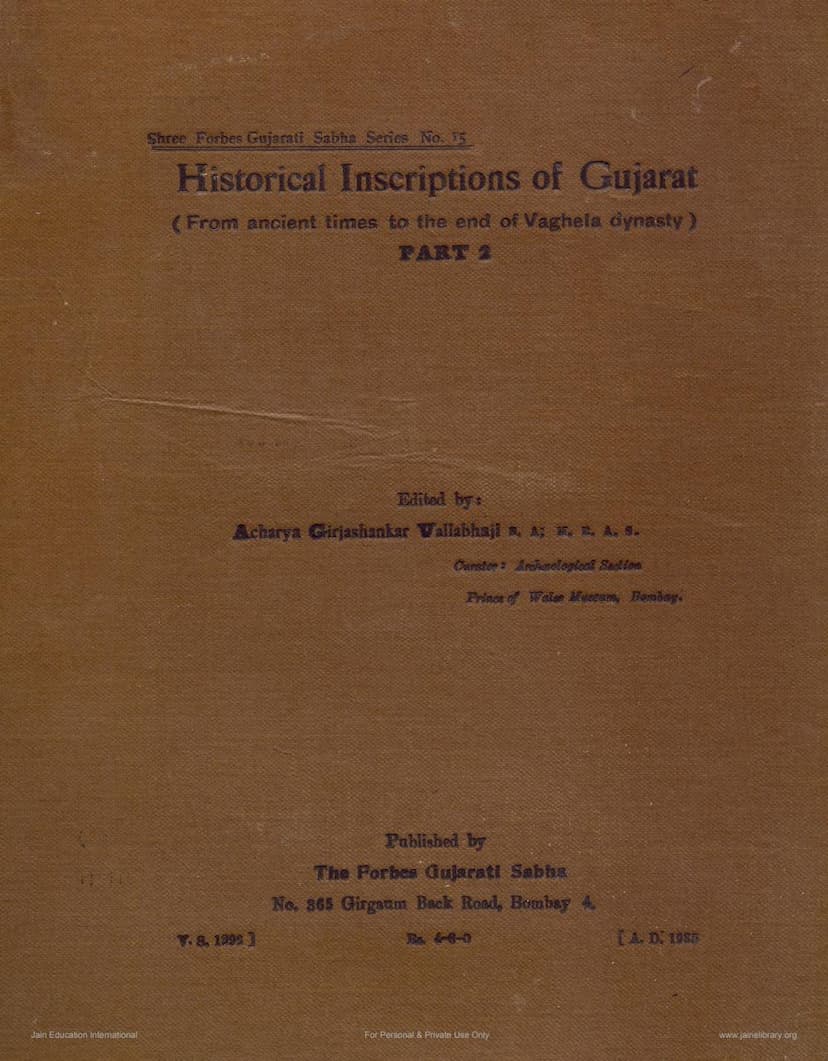Gujarat Na Aetihasik Lekho Part 02
Added to library: September 1, 2025

Summary
The book "Gujarat na Aetihasik Lekho Part 02" (Historical Inscriptions of Gujarat, Part 2) by Girjashankar Vallabh Acharya, published by The Forbes Gujarati Sabha, Bombay, in AD 1935 (VS 1992), is a collection of historical inscriptions from Gujarat, spanning from ancient times up to the end of the Vaghela dynasty. This particular volume, Part 2, focuses on inscriptions from the Gurjar period, starting from the Gurjar dynasty and extending to the Chalukya dynasty. The subsequent volume, Part 3, was planned to cover the Vaghela dynasty and other miscellaneous inscriptions. The introduction by the editor acknowledges that while the initial intention was to include all inscriptions, the size of the second part necessitated deferring some to a third part. There was also a plan to collect inscriptions from the Muslim period.
The editor addresses criticisms and suggestions received for the first volume, clarifying that the collection is a factual compilation and not a narrative novel, thus the absence of a continuous flow of narrative. They also explain that the scope of the collection aims to be expanded to include inscriptions outside Gujarat that are relevant to Gujarat's history, such as those found in Malwa and Mewar, as well as those related to the Rashtrakutas and Pratiharas who had influence over Gujarat at certain times. The editor confirms that inscriptions from outside Gujarat that are historically useful have been included, as have those related to the Rashtrakutas in Gujarat. A plan to compile a list of relevant inscriptions from outside Gujarat for the third volume was also mentioned.
The book contains a detailed index of collected inscriptions, listing the article number, details of the inscription, its current location, where it was published, and the corresponding page number. The inscriptions are categorized by dynasty, including:
- Gurjar Dynasty: A significant portion of the volume is dedicated to the inscriptions of the Gurjar dynasty, starting from inscription No. 108, detailing copper plate grants and other records with their corresponding dates (CE and VS), locations, and publication details. These inscriptions cover rulers like Dama II, Jayabhatta II and III, and others, with descriptions of their script, content, and historical significance.
- Rashtrakuta Dynasty: The volume also includes inscriptions from the Rashtrakuta dynasty, covering rulers like Karka II, Dhruva II and III, Govinda III, and Amoghavarsha I. The details provided are similar to the Gurjar inscriptions, including dates, locations, and publishing information.
- Chalukya Dynasty: A substantial section is dedicated to the inscriptions of the Chalukya dynasty, featuring rulers like Mularaja, Bhimadeva I, Karna, Siddharaja Jayasimha, and Kumarpal. The inscriptions detail their grants, prasastis (praise inscriptions), and other historical records. For example, the inscriptions of Mularaja, Bhimadeva, and Karnadeva provide insights into their reigns and administrative practices. The extensive inscriptions related to Kumarpal, particularly those from Vadnagar, highlight his patronage of Jainism and his military campaigns.
- Other Rulers/Miscellaneous: The index also includes inscriptions related to other rulers and periods up to the end of the Vaghela dynasty, such as those of Ajayapala and Tribhuvanapala.
The introduction and the detailed descriptions of the inscriptions highlight the scholarly effort by the editor, Acharya Girjashankar Vallabhaji, who was also the Curator of the Archaeological Section at the Prince of Wales Museum, Bombay. The book serves as a vital resource for historians and researchers interested in the political, social, religious, and administrative history of Gujarat during these significant periods, primarily drawing from Jain sources and inscriptions. The inclusion of original Sanskrit text with Gujarati translation (where applicable) and detailed commentary adds to the book's academic value.